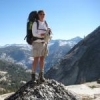I’ve mulling over the comments posted by our Alaskan correspondent…namely what is, or is not, wilderness, and if the difference should have any impact on my view of NAWAC’s evidence coming out of Area X.
Like a lot of words that come freighted with history and emotion, “wilderness†has many present interpretations. When the founders of Jamestown looked out from their redoubts into the woods surrounding them, they described this as “wilderness.†(Often preceded by the adjective “howlingâ€â€¦the absolute worst conditions for these self-styled “civilized†Europeans). That they were actually looking at a landscape that had been modified (through controlled fire) by natives for centuries, and had only recently been depopulated by European pathogens would not have crossed their minds. Wilderness it was to them, even though this very idea would have been amusing to the locals, I’m sure.
In the American psyche there has always been this longing for the lost Garden of Eden, while also being somewhat unsettled with the actual thing, rare though it was then and now. The idea was made federal law with the Wilderness Act. The Act tried to come to some accepted definition, and largely succeeded I think, but it left us with this legacy of defining wilderness by what is not present (i.e.: Man) instead of what IS there. More than that, it has served to further scramble our mutual understanding of the word. Wilderness (big “Wâ€) is now a legal/political construct. Wilderness (small “wâ€) is now more than ever in the eyes of the beholder. I like DWA’s definition myself, which is just one of many descriptors you could list: Wilderness is where you should be looking over your shoulder for the thing that can kill you. Does that include Area X? Well, I think the NAWAC folks on site will confirm that for you. And yes, it includes a lot of Alaska.
At the time the designation of the Sipsey Wilderness here in Alabama was proposed, many went on record as stating there was no wilderness in the East, so there was no land worthy of this protection in their view. Obviously, this was an overly narrow view of the matter and I’m glad to say it did not get much traction over the years. I also believe it stemmed from a view I think our Alaskan friend might share. That is, somehow, wilderness is a function of size, not complexity. It is certainly not equivalent to “pristine†because, if so, not much of what we have left fits the definition. I think it as ridiculous to say a small land area can’t be [W]ilderness as it is to say a large area is presumed to be. To my way of thinking, the absence of human activity is not as crucial. I know it when I see it, to quote Justice Brandeis. I’ve found it 20 minutes outside of town, and I’ve failed to find it at the end of a 30 mile one-way trail. The fact that thousands of people traverse Wilderness areas each year, from “The Bob†in Montana to the Cohutta in N.Ga. matters not a bit to my feelings about it being wilderness, Wilderness or any degree of wild on that scale.
But does this matter at all as to the NAWAC’s claims? No to me, no. If there were strong evidence a population of Wood Apes can only sustain itself in virgin timber and boundless expanses, I might be open to that idea. There isn’t. If you put credence in the encounter narratives, BF are found in a remarkable range of habitats. This seems to be one of them, or at least that is what the NAWAC is proposing, and trying to prove. Do their claims depend on you believing how wild an area this is? No again. I think it is only somewhat useful to appreciate how difficult a place to operate this area likely is. That, and you have to turn loose of your idea that this whole area was somehow transformed into a biological desert in the 19th-20th centuries. That never happened. But even if it did, we have many designated Wilderness areas in this country that were politically expedient choices for the designation only because they were so devastated no moneyed interest saw any further use for them. If you go to some of those, as I have, that history is not likely to make any impression on you to detract from your feelings of just how wild they are now. If there is one overarching lesson it is that wildness is very resilient. Whatever ecological insults we’ve lavished on Area X over the centuries, don’t think they’ve been permanent.



